Paradise in Harlem (1939) is a short musical comedy with minimalist story to justify the musical variety. The story includes gangsters, a mob murder, & comedian "Uncle Lem" (Frank L. Wilson) as witness to the murder. He's pressured by mobster Rough Jackson (Norman Astwood) to get out of town, or harm will come to his nephew.
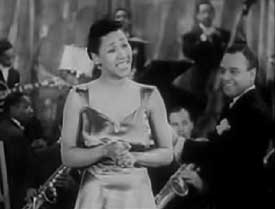 Uncle Lem is a minstrel-show style burnt cork black-face comic (even black comics would perform in black face on the chitlin circuit). But Lem dreams of being a serious Shakespearean actor, & has returned to Harlem because promised a chance to play Othello. Uncle Lem is a minstrel-show style burnt cork black-face comic (even black comics would perform in black face on the chitlin circuit). But Lem dreams of being a serious Shakespearean actor, & has returned to Harlem because promised a chance to play Othello.
As for the crime tale it's not bad, & Lem's struggle to not be run out of Harlem a second time while trying to keep harm from coming to friends & family, is heroic stuff. It's much more of a story than usually found in the all-black-cast musicals, & the acting is comparatively good too. Yet the greater power of this little film is indeen in the stage acts.
The stage show is started off with singer-dancer Lucky Millinder who with the band sings "I Got to Put You Down," & it's great in its boldness. Lucky wrote this number.
This is a rare opportunity to see Lucius Venable "Lucky" Millinder, who not only managed not to be filmed much, but usually headed an orchestra without personally singing. Lucky lead a successful Harlem & swing-circuit dance band leader in the 1940s, an influence in the major transition that was happening between big-band swing, & the new rhythm & blues.
Mamie Smith sings an outstanding blues number" "Lord Lord Lord Lord. I love my man but he treats me like a dog." In addition "Lord, I Love That Man" she sings Perry Bradford's "Harlem Blues" together with The Alphebetical Four, a first-rate harmonizing gospel quartet headed up by Emory Johnson. "Harlem Blues" is an updated version of her Roaring 'Twenties hit "Crazy Blues."
The title song "Harlem Serenade" was written by Vincent Valentini, & is performed by a jivin' jazz-singing beauty Edna Mae Harris, with a bit of support from Lucky..
Broadway performer Juanita Hall sings her own composition from the audience, "Gospel Version of Othello," with acapella support from Francine Everett, Frank C. Wilson & Babe Matthews.
Among Juanita's Broadway roles, she was Bloody Mary in South Pacific & Auntie Liang in Flower Drum Song, which roles she reprised respectively in the 1958 & 1961 film adaptations.
Feisty Babe Matthews sings Joe Thomson's "Why Am I So Blue?" the answer being her husband played by her real-life husband Eddie Matthews.
If all this short film had had going for it were the numbers by Edna Mae or Mamie, it'd be a winner, but in fact it has a good deal more
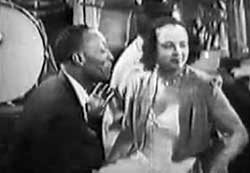 Dusty Brooks & His Four Tones are some great musicians, performing Satchel Mouth Baby (1946) with a solo for the pianist & for the guitarist before Dusty walks in with a gal, Mildred Boyd, whose role is mostly decorative. Dusty Brooks & His Four Tones are some great musicians, performing Satchel Mouth Baby (1946) with a solo for the pianist & for the guitarist before Dusty walks in with a gal, Mildred Boyd, whose role is mostly decorative.
Lucius "Dusty" Brooks is the lead vocalist. His Four Tones (Leon Buck, Ira Hardin, Rudolph Hunter, and Johnny Porter) harmonize as well as the Mills Brothers but with their own instrumentation & an edgier jazz power.
They're singing "Satchel Mouth Baby" which might less hiply but more accurately have been titled "You're the Cutest One." Dusty & Mildred Boyd also do a bit of soft dancing.
The song was a hit single for the group the year before they lipsynced it as a soundie. The single had "Two Tears Met" on the flipside. The group had briefly been film stars, singing in four all-black cowboy films including Two-Gun Man From Harlem (1938).
Mildred had been a bit player in Hollywood who like most young black actresses in a racist industry just couldn't break out of anonymous roles as "white lady's maid" or "Harlem dancer" usually without even getting her name in the cast credits.
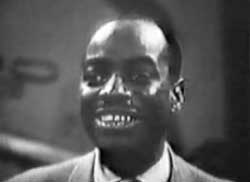 With a smooth jazz sound reminiscent of Nat King Cole, Tiny Grimes performs on guitar as he sings a boogywoogy swing tune Never Too Old to Swing (1945), & he's just super fine. With a smooth jazz sound reminiscent of Nat King Cole, Tiny Grimes performs on guitar as he sings a boogywoogy swing tune Never Too Old to Swing (1945), & he's just super fine.
At the point of the instrumental, a gorgeous dancer comes out & really cuts the rug, or the stage as the case may be.
Dressed up to look like a black club setting, this is one of the moodier finer soundies for music & for the general look, it really feels like a moment out of a small club concert with the small audience being really lucky.
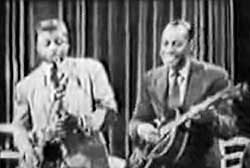 Tiny with his guitar & his orchestra do another soundie number Swingin' in the Groove (1945), his nearest thing to a big hit after leaving the Art Tatum Trio to establish his own group: Tiny with his guitar & his orchestra do another soundie number Swingin' in the Groove (1945), his nearest thing to a big hit after leaving the Art Tatum Trio to establish his own group:
"One for all & all for one/ That's the way it should be/ All for one & one for all/ That make everybody agree/ Ah you got to feel that crazy rhythm/ Gets down in your bones & you've got to move/ Start your hands clappin'/ Start your feet a tappin'/ Then you know you're swingin' in the groove."
At the instrumental three women rush out & do a dance routine. Tiny's sax player & pianist each get a solo.
As with other of Tiny's soundies in '45, the number appears to be recorded live, whereas most soundies had their sound recorded beforehand then the performers tried to match the performance for the camera on a completely different go-through. This sometimes lent an artificiality to the performances, but Tiny Grimes is the real deal throughout.
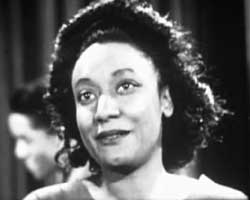 The Tiny Grimes Quintet one more puts Tiny out front with guitar as the lead instrument. Tiny is usually his quintet's singer, but he's not the lead singer for Romance without Finance (1945).
The Tiny Grimes Quintet one more puts Tiny out front with guitar as the lead instrument. Tiny is usually his quintet's singer, but he's not the lead singer for Romance without Finance (1945).
This song about never falling in love unless with someone who has money is jump-jazz upbeat & charming for all it's negative sentiment. An exceedingly talented female vocalist dominates the soundie: "Romance without finance is a nuisance/ Please baby give me some of that gold."
Alas this singer isn't identified, & she does not appear on the record release version which Grimes performed with Charlie Parker, who isn't in the soundie version. I've included a screen capture of the singer & hope someday someone passing along this page will recognize her & let me know who she is.
Throughout the vocal, our singer is addressing her rules & restrictions to a handsome slender fellow who just stands there taking it in.
At the instrumental break, however, he does a slow hep-cat kind of dance including the splits & concluding with a somewhat comic Charleston moment, as all the while Tiny plays a lead guitar solo. When the singer takes up the lyrics for the close, the dancer stands quietly again, nodding agreeably to the harsh rules.
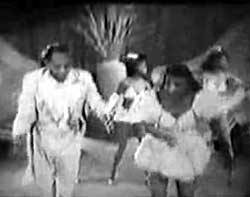 A troupe of gorgeous black dancers perform throughout this soundie, to the instrumentation of John Kirby & His Band, in Close Shave (1942), with Charlie Shavers to be heard on trumpet.
A troupe of gorgeous black dancers perform throughout this soundie, to the instrumentation of John Kirby & His Band, in Close Shave (1942), with Charlie Shavers to be heard on trumpet.
After the instrumental has gone on a while, lead dancers Leroy Broomfield & Aurora Greeley come stage-center to boogy up a storm.
Leroy was a Broadway hoofer who had been dancing since early in the Roaring Twenties & still cuts a fine figure in white tails & tux.
John Kirby & His Orchestra, billed as "the biggest little band in the land," is never seen but only heard in this little film. The dancers are performing to the record released the year before, & this could be called more of a "Dancie" than a soundie.
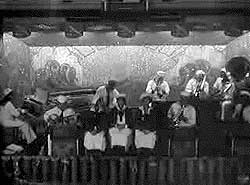 One of the odder musical review shorts was produced by the Feeber Film Corporation, Harlem Review (circa 1938), "with an all-star cast of radio performers."
One of the odder musical review shorts was produced by the Feeber Film Corporation, Harlem Review (circa 1938), "with an all-star cast of radio performers."
These all-stars are not well known today but presumedly had a serious following in Harlem & local radio appearances.
It begins with two awfully old-fashioned comics, one named Zazzy, playingblack sailors in black-face pealing potatoes, talking about how they preferred the African navy when "we was a couple of admirals."
The film then cuts to a shot of the "heathen respekkable" admirals' battleship the S.S. Topsy Africa, continuing the self-stereotyping humor which is strictly for minstral-show historical interest; it just no longer registers as funny.
Finally the band begins, with the Brown Sisters are sitting up front quietly during the ragtime instrumentation.
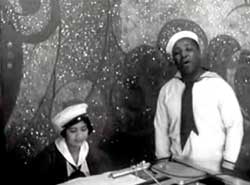 The three-storied set places the band deep in the hold of the ship, with dancers upstairs, & more sailors & their gals dancing on the poop-deck. The three-storied set places the band deep in the hold of the ship, with dancers upstairs, & more sailors & their gals dancing on the poop-deck.
This appears to be a real stage set for a live performance, & Harlem Review apparently documents an actual stage review.
Then with a title card "Introducing Bill Powers," we get to see the show's highliner singing William H. Gardner's "Caroline (Can't Yo' Hear Me Callin'"), a song that pre-dates the ragtime era.
One of the Brown Sisters is at the piano as Powers sings, wearing wave & sailor outfits respectively. Powers sounds almost Victorian with his highly trained voice & his extreme seriousness, but that's not a slam, he was a wonderful performer.
Powers' performance is followed by another title card "and now The Brown Sisters." They sing "Underneath the Harlem Moon" almost as though it were a New Orleans marching song.
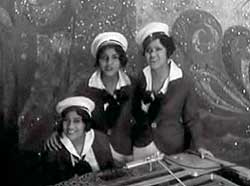 The lead-in concludes with the lyrics "You don't have to try so very hard/ The south is in your own back yard," then they leap into the sweet, sweet jazz number. The lead-in concludes with the lyrics "You don't have to try so very hard/ The south is in your own back yard," then they leap into the sweet, sweet jazz number.
These girls are so damned good, it's strange they're such obscure singers almost unremembered to history.
I've seen Harlem Review deplored as a racist short film, due to the comedians & some of the horrible set decorations which include some cut-outs of the worst black stereotypes.
Yet it was made by black folk for black folk & missed being reported in all white media documentations of the time. It looks like it would've been very old-fashioned even in the '30s, & is probably a very fair representations of "colored minstrel shows" in their waning years.
And I happen to think Bill Powers & especially the Brown Sisters were real talents, who were probably very well known to a part of the American population that was being ignored by the dominant culture.
copyright © by Paghat the Ratgirl
|
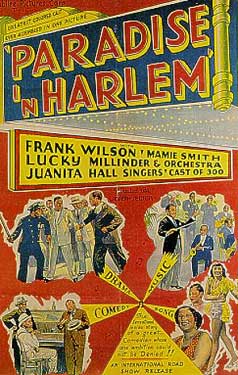
 Uncle Lem is a minstrel-show style burnt cork black-face comic (even black comics would perform in black face on the chitlin circuit). But Lem dreams of being a serious Shakespearean actor, & has returned to Harlem because promised a chance to play Othello.
Uncle Lem is a minstrel-show style burnt cork black-face comic (even black comics would perform in black face on the chitlin circuit). But Lem dreams of being a serious Shakespearean actor, & has returned to Harlem because promised a chance to play Othello.

 Tiny with his guitar & his orchestra do another soundie number Swingin' in the Groove (1945), his nearest thing to a big hit after leaving the Art Tatum Trio to establish his own group:
Tiny with his guitar & his orchestra do another soundie number Swingin' in the Groove (1945), his nearest thing to a big hit after leaving the Art Tatum Trio to establish his own group:


 The three-storied set places the band deep in the hold of the ship, with dancers upstairs, & more sailors & their gals dancing on the poop-deck.
The three-storied set places the band deep in the hold of the ship, with dancers upstairs, & more sailors & their gals dancing on the poop-deck. The lead-in concludes with the lyrics "You don't have to try so very hard/ The south is in your own back yard," then they leap into the sweet, sweet jazz number.
The lead-in concludes with the lyrics "You don't have to try so very hard/ The south is in your own back yard," then they leap into the sweet, sweet jazz number.